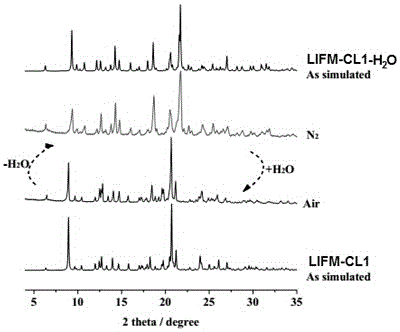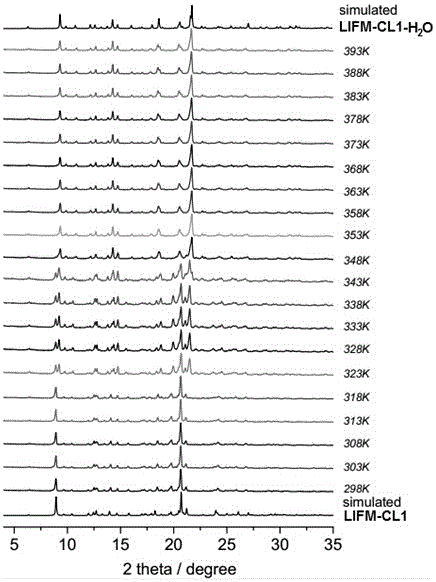Coordination compound LIFM-CL1 based on ESIPT (excited state intramolecular proton transfer) characteristics and preparation method and application thereof
A LIFM-CL1-H2O, complex technology, applied in the direction of zinc organic compounds, chemical instruments and methods, organic chemistry, etc., can solve the problems of difficult reuse, inability to realize detection, etc., achieve reversible water response, easy processing, beneficial to The effect of device application
- Summary
- Abstract
- Description
- Claims
- Application Information
AI Technical Summary
Problems solved by technology
Method used
Image
Examples
Embodiment 1
[0100] Embodiment 1 Preparation of organic ligand H2hpi2cf
[0101] 1. The preparation method of the organic ligand H2hpi2cf is as follows:
[0102] S1. Under nitrogen protection, a mixed solution of 5-aminoisophthalic acid (5mmol, 0.905g), 5-fluoro-2-hydroxy-benzaldehyde (3mmol, 0.420g) and acetic acid (20mL) was heated at 110°C stir for two hours;
[0103] S2. Add 4,4'-difluorobenzil (5mmol, 1.23g) and aminoacetic acid (50mmol, 3.85g) to the solution of S1, and continue to stir for 10 hours under heating conditions; S3. Cool to room temperature, and The white solid was filtered, washed several times with water, and then dried at 100°C to obtain H 2 The hpi2cf molecule.
[0104] 2. The structural formula of the organic ligand H2hpi2cf is as attached figure 1 shown.
Embodiment 2
[0105] Preparation of Example 2 Complex LIFM-CL1
[0106] h 2 The molecular structure of hpi2cf and the preparation of complex LIFM-CL1 are shown in the attached figure 1 shown.
[0107] 1. Preparation of complex LIFM-CL1:
[0108] Zinc nitrate hexahydrate (0.1mmol, 0.030g), H 2 hpi2cf (0.1mmol, 0.053g) was put into a 10mL reaction kettle lined with polytetrafluoroethylene, then 2mL water and 2mL N,N-dimethylacetamide were added, stirred evenly, covered and put into a matching stainless steel reaction vessel kettle. Put the reaction kettle into an oven, program the temperature to rise to 100°C for 2 hours, maintain this temperature for 50 hours, and cool down to room temperature for 10 hours. The mixture was filtered to obtain a colorless and transparent complex single crystal (blue fluorescence at 463nm under excitation at 365nm).
[0109] Or: zinc nitrate hexahydrate (0.1mmol, 0.030g), H 2 Put hpi2cf (0.1mmol, 0.053g) into a 15mL pressure-resistant reaction tube, ad...
Embodiment 3
[0117] Example 3 Preparation of Fluorescent Water Responsive Film
[0118] Method 1: Fully grind the complex LIFM-CL1, take 0.020g powder and disperse it in 10mL methanol solvent, and evenly smear it on non-fluorescent paper (that is, any other type of paper that is not fluorescent paper, such as filter paper, non-fluorescent picture Paper, etc.) to obtain a fluorescent film with a paper substrate (463nm blue fluorescence under 365nm excitation), which is also recorded as fluorescent paper;
[0119] Method 2: Fully grind the complex LIFM-CL1, take 0.020g powder and disperse it in 10mL n-heptane solvent, add 0.2g RTV silicone rubber, ultrasonic for 10 minutes, put the mixture in a mold with a certain shape, and let it stand at room temperature. Set aside for about 3 hours to fully volatilize the solvent to obtain a transparent and flexible fluorescent film material (463nm blue fluorescence under 365nm excitation), which is also recorded as RTV fluorescent film.
PUM
 Login to View More
Login to View More Abstract
Description
Claims
Application Information
 Login to View More
Login to View More - R&D
- Intellectual Property
- Life Sciences
- Materials
- Tech Scout
- Unparalleled Data Quality
- Higher Quality Content
- 60% Fewer Hallucinations
Browse by: Latest US Patents, China's latest patents, Technical Efficacy Thesaurus, Application Domain, Technology Topic, Popular Technical Reports.
© 2025 PatSnap. All rights reserved.Legal|Privacy policy|Modern Slavery Act Transparency Statement|Sitemap|About US| Contact US: help@patsnap.com



